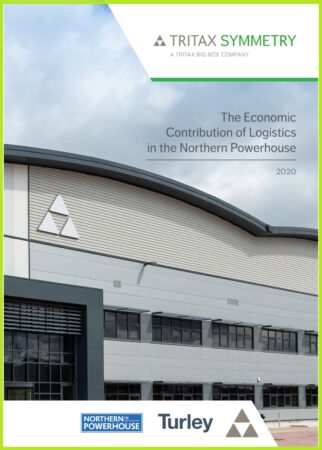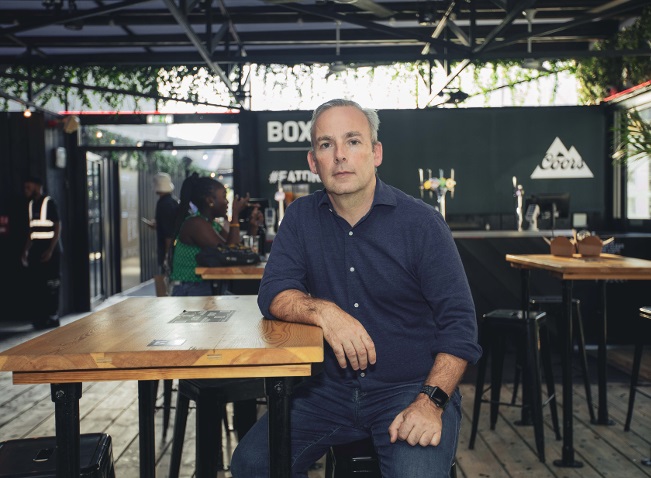VIDEO | Economic potential of Northern Powerhouse logistics
Large-scale industrial developments are not always an easy sell and the sector has a duty to better communicate its economic value to laypeople and decision makers alike, according to a panel of experts at a roundtable held by Tritax Symmetry.
The industrial developer this week published a report by consultancy Turley examining the sector’s growth potential.
Part of the FTSE 250-listed Tritax Big Box Reit, Tritax Symmetry concluded from the report that the logistics sector in the North could achieve transformational growth locally and nationally and create an additional 174,000 jobs by 2050, if key barriers are addressed.
Place North West publisher Paul Unger hosted the discussion with a panel of professionals including report author Amy Gilham from Turley, and Tritax Symmetry directors Andrew Dickman and Matt Claxton.
The panel:
- Andrew Dickman, director, Tritax Symmetry
- Amy Gilham, director of economics and head of logistics at Turley
- Jason Print, partner, industrial agency, Gerald Eve
- Catherine Fearnhead, real estate partner, Addleshaw Goddard
- Martin Chapman, commercial operations manager, Croda
- Matt Claxton, planning director, Tritax Symmetry
Key questions:
- What are the supply and demand factors affecting logistics take-up in the region and how is this projected to change in the coming years?
- How has the pandemic altered logistics operations and what are the real estate implications?
- Can recent policy announcements, such as the Planning for the Future white paper published this month, effectively support the sector’s growth?
Main takeaways:
- There is a stark mismatch between rapidly rising occupier demand for industrial space as the pandemic accelerates online retail trends and the need for storage and distribution, and a dwindling supply of land to accommodate their needs
- Skillsets in logistics have changed dramatically over the past decade, becoming more diverse, qualified, managerial, and technologically sophisticated
- Major improvements in infrastructure, skills, connectivity, planning and policy making are required if the sector is to achieve its “transformative” potential
The report came about “following talks between Matt and I about a specific problem we encounter on almost every development site we plan”, said Andrew Dickman, kicking off the discussion.
That problem, he said, is the common failure by laypeople and others, who are not necessarily part of the planning process but are nonetheless stakeholders, to properly understand what logistics is and the employment opportunities it presents.
“We wanted to produce something that communicated the skillsets within logistics and the number of workstreams involved, to give people a more positive view of the sector than perhaps they might have,” he said.
As logistics becomes increasingly automated, there is a need for a greater range of skills, including IT practitioners and electrical engineers, and wages are now higher than the UK average as a result, Dickman noted.
Under the 2016 Northern Powerhouse Independent Economic Review, cited in Turley’s report, the sector is identified as having the potential to generate an average of 4,970 jobs each year to 2050, and £845m in gross value add economic growth per year, resulting in an estimated annual salary increase of £5.3bn and an additional 29,190 professional positions.
Despite this, “it’s not always an easy political sell to deliver a large-scale industrial building in a, say, agricultural setting. People don’t like change,” Dickman added. But there has been an interesting change in emphasis lately, he added – “a view that, actually, logistics provides ‘somewhere for our people to work’.
“And this is how the industry needs to be seen. This is what we need to be saying to the world: that we create a wide range of jobs for the local area with higher than average wages and huge potential for growth.”
The biggest barrier to such growth is supply of good quality industrial land, Dickman said.
“We have less than one year’s supply of grade A logistics space across the region based on average take-up figures from previous years, and yet in an unusual world we saw the second highest take-up in Q2 ever seen in the UK.
“Demand is running at a highly above accelerated average, which only tells us that the supply we do have will be gobbled up faster than we expect,” he warned.
Matt Claxton agreed that “few people realise just how important logistics is to the UK economy, and to the Northern Powerhouse in particular”.
He noted that Turley’s research shows an 80% increase in the number of logistics businesses in the region since 2014, to 23,000, and a 24% increase in the number of employees in the sector since 2013, to 263,000, as well as an increase in the diversity of jobs. “This isn’t just about two men in a warehouse. The sector offers all kinds of highly skilled jobs,” he said.
However, there are “stumbling blocks” to the industry growing further, including shortage of land supply and gaps in the planning system, “which to date hasn’t fully accepted the true economic power of the logistics industry”, Claxton warned.
“For example, the Government’s planning white paper does not go nearly far enough in terms of supporting logistics growth. We’ve done a word search [of the paper] and ‘employment’ comes up twice and ‘distribution’ has just three mentions, so an awful lot more needs to be done.”
There is currently between 4.5m sq ft and 5m sq ft of logistics space requirement in the North West, and occupiers need quality, modern space to suit their needs, not second-hand industrial units, many of which are being taken up for residential development, Claxton added.
“Change of use from employment to residential seems to be easily done within the planning system, but this isn’t the case when it comes to change of use from residential to industrial.
“I think this is because local authorities are worrying politically about voters and councillors and what people are going to think,” he said.
Amy Gilham noted that the Northern Powerhouse regions, including the North West, North East, and Yorkshire and the Humber, account for one-third of England’s industrial floorspace and number of warehouses. “This is significant and means there is a real impetus to recognise logistics as a valuable sector and ensure that the planning and policy is in place for it to deliver its potential,” she said.

The timing of the report’s publication is key, because the months of lockdown have shown the layperson for the first time the tangible effect of logistics not operating as it should – for example, when items were missing from supermarket shelves at the start of the crisis.
In addition, the North West is one of the larger online spend areas of the UK, so the sector is particularly important here and ‘last mile delivery’ – the movement of goods from a transportation hub or warehouse to its final delivery destination – “will be a growing part of the logistics industry, meaning cities will play a bigger role in terms of providing locations for warehouses, not just [out-of-town] sites to house larger land requirements,” Gilham said.
She, too, expressed concern over dwindling supply of land. Turley’s report notes that the growth in logistics has the potential to create 5,000 jobs per year, using 3,000 hectares of land, by 2050, and yet such swathes of land are not available.
“I’ve seen we have about one year left of logistics supply in the North West but that figure could actually be eroded given that we’ve had such recent rapid take-up amid the pandemic this year,” Gilham said. The lack of mention of logistics in the planning white paper is “surprising”, she added, when viewed in comparison to housing, for which the paper moots a revised standard methodology for councils to calculate residential land supply.
A similar methodology for how employment land should be calculated in a particular area is needed, together with other policy, transport and infrastructure initiatives to support the sector’s growth, Gilham said.
She also noted that the pandemic has resulted in a “transition of people from failing retail positions to logistics roles, particularly within online retail as they have similar skillsets”, and this trend is likely to continue and should be considered in local industrial strategies.
For industrial agent Jason Print, the supply-demand mismatch is a cause for concern. “On the demand side, the growth is phenomenal, it’s great. But on the supply side there’s isn’t enough. It’s a massive problem,” he said.
Take the well-documented increase in online sales spend, from 7% of total retail sales in 2010, to at least 20% at the start of this year and then a jump to 30% over the last six months, he said. “We have clients who say that in the last three months alone they have had five years’ worth of growth. Demand has skyrocketed!”
National take-up of logistics space rose 17% year-on-year in the first six months of this year to 14m sq ft, Print noted. Amazon has reported that it either concluded deals, or secured planning permission, for more than 6m sq ft of industrial space in Q2.
And growth in online retail is not the only driver, he added. “An increasing number of manufacturing companies are ‘onshoring’ because they’ve had enough of long supply chains [which are more prone to disruption].”
All of this has led to a surge in deals and demand for space ranging between 150,000 and 800,000 sq ft. “There been a large number of large, greenbelt sites that have been called in lately and industrial agents are asking ‘why’? They can’t get the sites to satisfy demand,” Print said.
City regions such as Manchester need at least one more site of 30-acre plus to meet future demand, while Warrington is also “pretty full up right now” and there are only a few available pieces of land around Liverpool. “Councils may say they have the land, but it’s made up of fragmented sites that can’t alone take a decent sized industrial unit.
“There is a big issue with their employment land supply,” he said.
Martin Chapman said the Northern Powerhouse agenda is an “exciting opportunity for the logistics industry, as we have a lot of the right things physically and geographically to support the sector’s growth.”
The current situation has made occupiers like Croda, which produces and distributes manufacturing materials for a range of industries including pharmaceutical, more aware than ever of the difficulties of long supply chains – “they are not as sustainable nor as tenable as once imagined” – and are increasingly looking for a local source, and more stock holdings. The looming spectre of Brexit will only increase this need, Chapman noted.
Meanwhile, other factors that are driving change within logistics and fuelling its growth include changing skills needs. “The skills base of a modern logistics occupier has shifted in the past 5-10 years away from the traditional pure truck driver – lifting the item down from a rack and driving it on to a vehicle.
“The facilities we use now involve a lot of self-driving vehicles, electrical engineering, software support and other digital infrastructure, and the more automation you use to make your operation efficient, the more sophisticated your infrastructure needs to be.”
However, sourcing such skills in the preferred locations has been a challenge and there remains a stark skills gap, he added. “There is a bit of disjoint between the traditional academic focus of many local education providers, and the needs of a business like us.
“We are still looking for the Holy Grail of what a college is willing to provide and what a business is willing to pay for.”
Another issue is changing design requirements as occupiers seek modern, sophisticated, technologically enabled space. “Bespoke requirements are cropping up more frequently than off-the-peg requirements, which makes repurposing old warehouse quite challenging,” he said.
Catherine Fearnhead agreed that there a regional skills gap is impacting North West logistics and is “something that could be addressed through greater devolution to local authorities”. This is something on which her firm, as part of the Northern Powerhouse Partnership is lobbying Government.
Another key area of focus for the partnership, which is needed to support growth of logistics in the years ahead, is better connectivity, she said.
“Connectivity – both transport and digital – is one of the four priorities the [partnership] has identified as a way of realising the potential of the Northern Powerhouse and promoting it on the world stage.
She added: “Logistics is a crucial enabler of connectivity, so the industry is recognised as essential for enabling that growth, [both because it needs it, and maintains it]. So we’re looking closely at the opportunities presented by the region’s seaports and airports, by the High Speed Two [rail link], by freight lines, and so on.
“All of this is very much at the forefront of our Government lobbying efforts.”
Fearnhead said, encouragingly, there is no North-South divide when it comes to the logistics sector. “The talk used to be all about the ‘Golden Triangle’ [a term coined in the 1980s to refer to an industrial heartland of the Midlands bounded by the M1, M6 and M69].

“But actually, the growth of the industry in the North has been phenomenal – the Golden Triangle is no longer the centre of demand, and probably for logistics, the ‘levelling up’ [of which Prime Minister Boris Johnson speaks] has already happened.”




